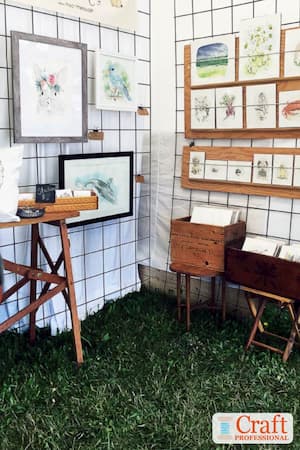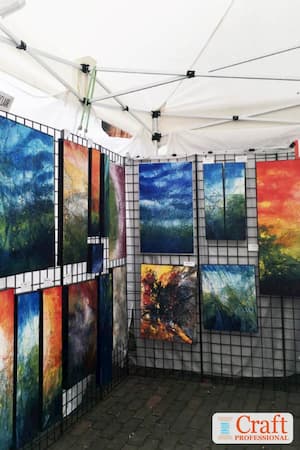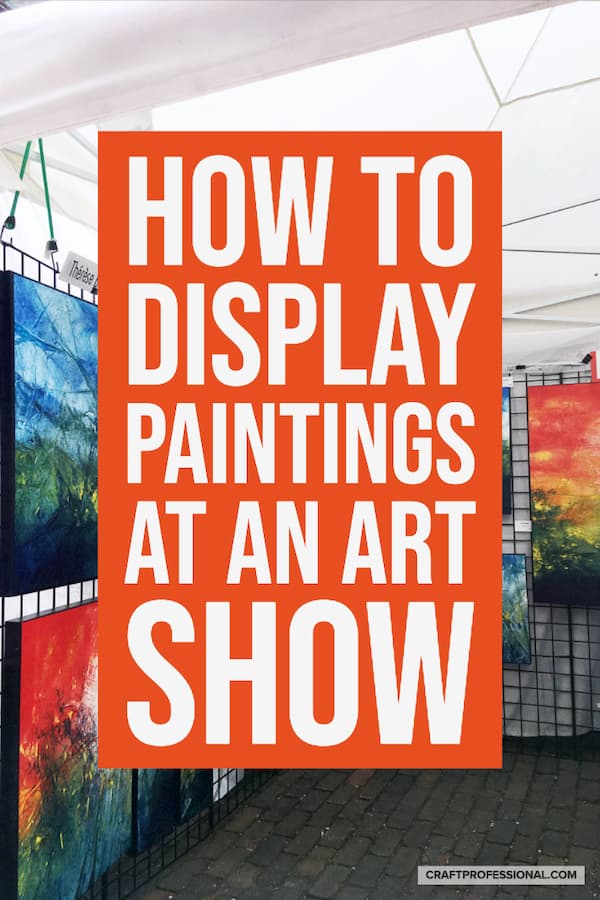How to Display Paintings at an Art Show
How to display paintings at an art show including: portable art display ideas for large canvases, tips for displaying smaller prints and cards, and general craft booth design best practices.
How to display larger canvases and original art
Large paintings, photographs, and other types of wall art are usually displayed on the walls of a portable tent at craft shows.
You can display your art on your tent walls using:
- portable gridwall panels
- chains or sturdy straps
- a mesh sidewall panel system that is specifically designed for art displays and attaches to your craft tent frame
If you're looking for a mesh panel art display system, Flourish is a popular brand.
Do not confuse mesh panels designed for art display with mesh netting walls used for keeping bugs out of a portable canopy. Mesh bug netting is not designed to support the weight of your paintings.
I earn a commission for purchases made through links on this page.
To learn more, please see my disclosure.
Consider Displaying a Painting on an Art Display Easel
Some artists use a display easel to show their work at art fairs. An easel can be placed at a front corner of your booth to help draw attention to your work. It's an effective way to feature one of your most eye-catching paintings.
Look for a sturdy art display easel that isn't too light, so it will stand up to some wind at outdoor shows. Some easels come with clamps that hold your art in place, making them more sturdy.
Check the dimensions of any art display easel you buy. Make sure the height is appropriate for your needs. Also, check the size and weight of canvas it will hold to ensure it will work with the art you want to display.
How to Display Art Prints for Sale
Smaller art prints and cards can be displayed effectively using:
- wood crates
- baskets
- greeting card display racks
Choose the Right Tables to Display Your Art Prints
If you use a tabletop display for your prints, be aware of your display's height and width.
 Art prints by The Critter Co. on display at a craft show
Art prints by The Critter Co. on display at a craft showRachel, owner of The Critter Co., has displayed her work (pictured here) beautifully at eye level and left plenty of space for shoppers to browse.
Standard tables are approximately 30 inches high, which is too low for shoppers to browse comfortably. A tabletop display should be raised to counter height, so shoppers can browse without bending over.
Also be careful about the width of your table. Many tables are 30-36 inches wide, which can be too big for a 10x10 foot craft booth.
Luckily, there are portable, adjustable height tables on the market that are just 24 inches wide, which is a better fit for most 10x10 art booth spaces.
Protect your Art Prints and Cards
You do want to encourage shoppers to browse your prints and cards because that can boost the chances of them buying. However, all of that handling can cause wear and tear on your prints.
You can protect your prints from the wear and tear of browsers' handling with clear plastic bags. They are an affordable investment in protecting your inventory and can be purchased at art supply shops.
Best Practices for Displaying Paintings at an Art Show
Finally, when designing your art display, keep in mind these best practices:
- Large-scale art draws shoppers' attention from a distance.
- Grouping a series of paintings or a unified color scheme adds impact and drama.
- Displaying a large piece on an outside wall can draw customers from more directions.
- The color of your backdrop impacts your display and must enhance your art.
- Good lighting is essential to show your work at its best.
Large-scale art draws shoppers' attention from a distance
The next photo shows gorgeous paintings by artist Therese Boisclair displayed in her booth at an outdoor show. Notice how well her striking work draws attention to her space.
 Beautiful paintings by artist Therese Boisclair.
Beautiful paintings by artist Therese Boisclair.If you have larger, eye-catching pieces to display, you may not need the help of additional signs or merchandising props. Your paintings will speak for themselves.
If, on the other hand, you work on a smaller scale, consider creating a larger version of one of your most impactful items to help customers see your work from a distance. A large-scale poster of your art can accomplish this task easily.
I've worked with my local print shop to create an original, large-scale poster. They were affordable and fabulous to work with. The end result looked great, and the work was completed quite quickly.
You can get this kind of work done online, but if you have a print shop in your area, and you want to create a large-scale poster for your booth, they can be a great place to start your research.
Grouping a series of paintings or a unified color scheme adds impact and drama
If you have several pieces that share a unified theme or color scheme, don't break them up. Hang them together as a group. Art displayed in a unified grouping will create a more impactful and dramatic display.
Displaying a large piece on an outside wall can draw customers from more directions
If your booth space is at the end of a row, and one side of your tent is open to customer traffic and sightlines, consider displaying a large, eye-catching canvas on the outside-facing wall. It will give approaching customers a look at your style before they even reach your booth and can help draw shoppers from more directions.
The color of your backdrop impacts your display and must enhance your art
Think carefully about the color of the backdrop you use.
Most often, paintings are displayed against a white backdrop at art fairs. If you use mesh display panels, they are easy to find in white, and if you use another system to hang your art, like grid wall panels, you can use white tent sidewalls as a backdrop to block the view beyond your tent. White is a good, neutral choice that works well in most settings.
You'll also see some art displayed against a black background. Black creates a rich and dramatic look, and it is neutral, so it won't fight against the colors in your work.
Occasionally, artists use color or a natural wood backdrop on the walls of their display space. That look can work if it suits the art on display, but do be aware that a backdrop that isn't neutral can affect the impact of your work.
If you choose to use a colored backdrop, make sure it enhances, and doesn't work against, the aesthetic of your art.
Good lighting is essential to show your work at its best.
All kinds of craft show booths benefit from good display lighting, including art displays. It's easy to overlook lighting, but, particularly if you're displaying in large halls, effective portable lighting is essential to showing your work at its best.



New! Comments
Have your say about what you just read! Leave me a comment in the box below.